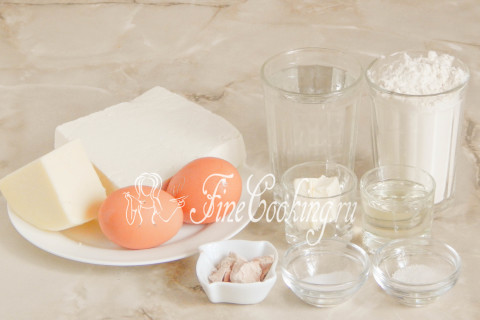Step 1
The following ingredients include the Khachapuri recipe in the Ajar recipe: wheat flour, water, water, chicken eggs, two types of cheese: Adyghe and suluguni, fresh yeast, refined vegetable oil (I have sunflower) and butter (for serving), salt and sugar. The yeast is not necessary to take fresh — just dry (3 grams is a teaspoon without a slide) or fast -acting (also 3 grams). The latter do not need to be activated in liquids — they are immediately introduced into flour.
Step 2
So, first we will make dough. Perhaps you ask for what is the dice and why it is needed. I won’t write a lot and for a long time that the bottom line is that this is a semi -finished product that is used to baking bread and other bakery products and increases the plasticity of the dough. In other words, this mixture of flour, water and yeast helps to achieve a more delicate and porous crumb, as well as a more saturated taste and aroma of finished baking. We will make the dough of medium density, for which we pour 200 milliliters of slightly warm water into the bowl, crumble 10 grams of pressed yeast there, add 0.5 teaspoon of sugar. Mix everything thoroughly so that the yeast and sugar dissolve.
Step 3
Next we pour approximately 3-4 tablespoons of sifted wheat flour (take from the total) and half a teaspoon of salt.
Step 4
Once again, we mix everything so that there are no lumps left. We leave the dough to wander in a warm place for 30-40 minutes. Depending on the temperature in the room, fermentation time may vary. A sign that the dumped is thrown out, will serve its appearance. First of all, initially not a particularly dense dough will dilute even more, greatly increased in volume, it will be pierced by bubbles and begin to settle.
Step 5
In the dishes for the batch of dough, we sift the rest of the wheat flour (in general, depending on its quality and humidity, it may be needed more or less).
Step 6
Pour the finished dough there in the same place — it has become completely liquid and flows like kefir.
Step 7
We begin the batch of the dough. You can knead this dough with your hands, but it is more convenient and faster to do it in a test or bread maker. At first, the flour absorbs fluid into itself and the dough becomes relatively homogeneous.
Step 8
Then we gradually add 40 milliliters of vegetable oil to it.
Step 9
To knead this yeast dough needs for a long time. With your hands at least 15 minutes, tests (bread maker) will cope in 10 minutes. The dough is very soft and delicate, and even very sticky — this is normal. By the way, if you knead it on the table, help yourself with a scraper. Surely it seems to you that the dough looks like a shapeless sticky mass, right? Yes, it is. But it is precisely due to increased humidity in the finished form that the dough in the Ajara khachapuri will pleasantly surprise you with its tenderness and porosity.
Step 10
We lubricate the bowl with a small amount of vegetable oil (I did not indicate it in the ingredients, but you are enough for 1 teaspoon), put the dough in it and tighten it with a film — it needs rest for an hour. During this time, every 20 minutes it will be necessary to fold the dough so that it is filled with air bubbles. When the first 20 minutes pass, we begin to fold the dough. This can be done directly in a bowl or dumping the dough on the work surface. Lubricate the hands with vegetable oil. Visually, divide the dough into 4 parts, that is, to get 4 sides. We raise one edge of the dough with your fingers (we take it directly from the middle at the bottom), stretch it to you, and then move it to the opposite edge. Similarly, we act on the second, third and fourth side. The most delicate dough is excellent from dishes, as we greased it with oil. Turn the dough and round it with our hands. We tighten the film again and let it rest for another 20 minutes in the warmth. Not to say that during this time the dough will rise strongly — rather, it will spread through the bowl. Again, fold it, as I showed above, and again to rest for 20 minutes. The last time we stretch the dough and let him rest for 10-20 minutes.
Step 11
At this time, let's take up the filling. To do this, just rub two types of cheese on a fine grater.
Step 12
Add about 100 grams of cold water and knead everything thoroughly with our hands. If the filling is not salty, be sure to sunbathe it to your taste. According to the consistency, cheese filling for khachapuri in Ajars should be delicate, soft and poorly keep in shape.
Step 13
Divide it into 2 equal parts, as we are going to make 2 khachapuri. While we leave the filling on the table and turn on the oven to heat up 240 degrees.
Step 14
The dough has rested, it is all pierced by a huge number of bubbles — from small to large.
Step 15
Gently divide it into 2 equal parts and transfer it to the working surface, quite generously sprinkled with wheat flour (we take additionally).
Step 16
Gently round the dough, trying to maintain its volume. We cover the dough with a film and let the bunks rest for 10-15 minutes, so that later they are more malleable and stretch well.
Step 17
Then begins the process of forming future khachapuri in Ajars. We take one piece of dough (we still cover the second with a bowl or film so that it does not be swollen) and slightly powder it with flour. We stretch the bell of the dough with your hands into a fairly thin (about 1 centimeter) square. We do not use a rolling pin so as not to squeeze the air out of the dough.
Step 18
After that, twist the dough from two ends so that it turns out a rectangle with sides and a thin middle. Sweep excess flour with a brush.
Step 19
It remains to connect the opposite ends in the form of a boat, carefully pinching the seam. Similarly, we act with the second piece of dough.
Step 20
We shift our boats from dough to a baking sheet covered with baking paper and slightly sprinkled with flour. We stretch them with our hands so that the middle is thin, and the blanks themselves are beautiful and neat.
Step 21
We fill the boats with a cheese filling, leaving it with your hands or spoon. We put in a hot oven to an average level.
Step 22
Bake khachapuri in Ajar must certainly be in a very hot oven with steam at 220-240 degrees. Such a high temperature is simply necessary, since we have a bread dough at the heart of baking. It contains a scanty amount of sugar, so at a low temperature the crust will be blurred reluctantly. So, you bake Adjar khachapuri for the first 5-7 minutes by steam, then we reduce the temperature to 200 degrees and bake for another 10 minutes. Steam can be created in two ways. Firstly, just throw several large ice cubes in the already warmed oven at the very bottom. Or put a bowl of water on the bottom in advance. During the baking, the steam will rise up, thereby helping the products rise. In addition, pastries for a couple contribute to the fact that finished bread products have a thin and delicate crust.
Step 23
Just a couple of minutes before the end of the baking, we take the khachapuri from the oven and drive chicken eggs into them, making a hole in the cheese filling. It is possible without eggs — also an option. Eggs can not be used as a whole, but only the yolk and part of the protein.
Step 24
Again, put khachapuri in the oven for about a minute. The protein should grasp, while the yolk remains completely liquid.
Step 25
They serve khachapuri in Ajar hot, immediately from the oven, if desired, sprinkled with chopped fresh herbs. Do not forget to put on top a piece of butter, which instantly melts and makes the filling even tastier and fragrant. Try it, it's amazing!

























